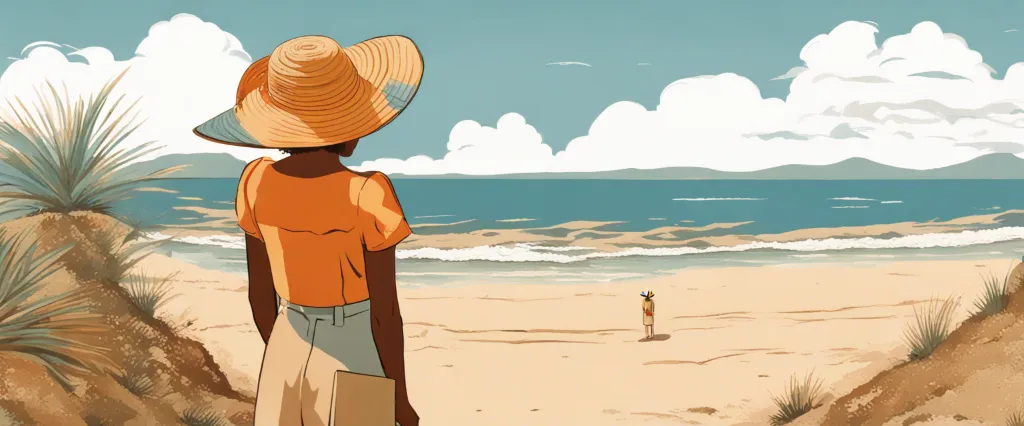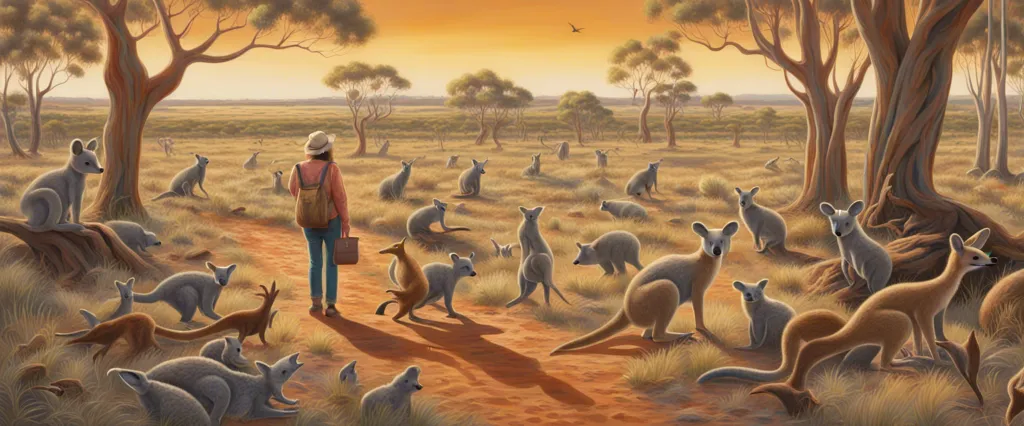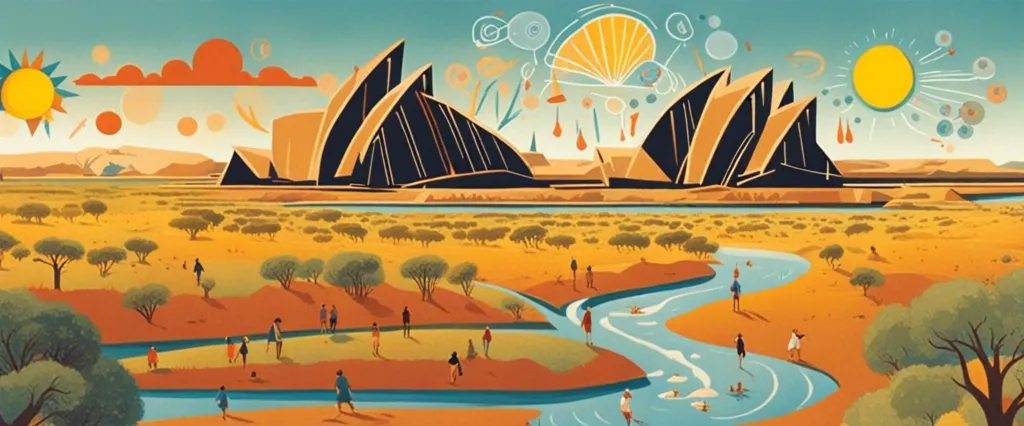
In “In a Sunburned Country,” Bill Bryson takes readers on an incredible journey across the vast and diverse land of Australia. With his characteristic wit and keen observations, Bryson presents an amusing and enlightening account of his exploration of this captivating continent. Renowned for his travel writing, Bryson’s engaging storytelling and meticulous research make him one of the most beloved authors in the genre. Having explored a multitude of destinations worldwide, his ability to inject humor into his narratives while delving into the history, culture, and natural wonders of each locale ensures an entertaining and informative read. Join Bill Bryson as he embarks on an unforgettable adventure through the land down under in “In a Sunburned Country.
Chapter 1: The Land Down Under
Chapter 1, “The Land Down Under,” from the book In a Sunburned Country by Bill Bryson, provides readers with an introduction to Australia, its vastness, and its unique characteristics. Bryson, an American travel writer, begins by describing his fascination with the country since childhood and his eagerness to explore it.
He highlights the sheer size of Australia, almost the same size as the continental United States, with a population density that is one of the lowest in the world. Bryson humorously mentions that, based on its size and emptiness, Australia could easily contain all the other nations on Earth. He also points out various interesting aspects of the country, such as being home to the world’s longest fence, the largest monolith, and the largest living thing on earth, the Great Barrier Reef.
Bryson shares intriguing historical anecdotes, like the discovery of Australia by Captain James Cook, the early British settlements, and the country’s initial use as a penal colony. He also highlights the harsh realities faced by the early European settlers due to the unfamiliar terrain, dangerous wildlife, and extreme climate.
Furthermore, the author emphasizes Australia’s unique and diverse wildlife, which is frequently referred to as the most venomous and dangerous in the world. Bryson describes the numerous deadly creatures that inhabit the continent, including spiders, snakes, jellyfish, and sharks, illustrating the potentially dangerous encounters that visitors must be aware of.
As the chapter concludes, Bryson expresses his excitement and apprehension about exploring Australia further, giving readers a glimpse into the adventure and insights they can expect from the rest of the book.
Chapter 2: The Australian Wildlife
Chapter 2 of “In a Sunburned Country” by Bill Bryson explores the unique and diverse wildlife found in Australia. The chapter begins by highlighting the country’s isolation, as it has been separated from the rest of the world for millions of years, allowing for the evolution of distinct and fascinating species.
Bryson first introduces kangaroos, iconic creatures synonymous with Australia. He recounts his encounter with a group of kangaroos while driving, describing their remarkable agility and unmatched grace. He also delves into their interesting anatomy, such as their muscular tails, powerful legs, and reproductive methods.
Moving on, the author discusses Australia’s deadly creatures, like snakes and spiders. He emphasizes the country’s reputation for having the most venomous species on the planet, including the infamous funnel-web spider and the fearsome brown snake. Bryson explains the urgency with which Australians respond to any potential snake sightings due to their lethality.
Additionally, Bryson highlights the renowned Great Barrier Reef, describing it as the largest living entity on Earth. He emphasizes the reef’s unparalleled biodiversity, offering insight into the countless varieties of marine life found there, including vibrant coral formations, colorful fish, and turtles.
The chapter concludes by exploring the curiosity and fascination Australians have with their unique fauna. The country has a strong commitment to protecting its wildlife, with various conservation initiatives and national parks dedicated to preserving the native species. Bryson reflects on how Australia’s wildlife is a significant part of the country’s identity and a source of immense pride for its inhabitants.
Overall, Chapter 2 gives readers a glimpse into Australia’s incredible wildlife, highlighting its diversity, dangers, and the efforts to protect and admire these remarkable creatures.
Chapter 3: Exploring the Outback
Chapter 3 of “In a Sunburned Country” by Bill Bryson is titled “Exploring the Outback.” In this chapter, Bryson sets out to explore the remote and vast Australian Outback, encountering various unique landscapes, wildlife, and cultures along the way.
Starting his journey in Birdsville, a small town in the heart of Outback Queensland, Bryson is immediately struck by the vastness and emptiness of the region. He travels through the Simpson Desert, a daunting and harsh terrain where sand dunes stretch for miles. Bryson learns about the difficulties faced by early explorers who ventured into this barren landscape.
Next, he explores the region of Coober Pedy, famous for its opal mines. Bryson describes the eccentric underground dwellings where some residents live to escape the extreme heat aboveground. He also learns about the challenging and often treacherous opal mining industry and its impact on the town’s economy.
Continuing his journey, Bryson visits the Oodnadatta Track, a historic route that passes through remote Aboriginal communities. He acquaints himself with the indigenous culture and the difficulties faced by Aboriginal people due to the history of colonization and marginalization.
Bryson’s travels also take him to Alice Springs, the largest town in central Australia. Here, he explores the MacDonnell Ranges and learns about the region’s unique flora and fauna. He also becomes aware of the challenges faced by many remote towns, such as limited resources and isolation.
Throughout this chapter, Bryson highlights the awe-inspiring beauty and unforgiving nature of the Australian Outback. The vastness and remoteness of the region, combined with the unique cultures and history, leave a lasting impression on the author’s mind, reinforcing his fascination with this sunburned country.
Chapter 4: The Indigenous Culture

Chapter 4: The Indigenous Culture in the book “In a Sunburned Country” by Bill Bryson explores the rich and diverse indigenous culture of Australia. Bryson takes readers on a journey to understand the ancient history, traditions, and lifestyles of the Aboriginal people, who have inhabited the land for more than 50,000 years.
Bryson begins by highlighting the significance of Dreamtime, the Aboriginal creation mythology that forms the basis of their belief system. Dreamtime intertwines creation stories with explanations of natural phenomena, giving a deep spiritual connection to the land. The author also discusses the vast linguistic diversity within Aboriginal cultures, with over 500 distinct languages spoken by the various tribes.
In exploring the indigenous culture, Bryson delves into the struggles faced by the Aboriginal people due to European colonization. He examines the impact of European diseases, violent conflicts, forced labor, and the forced removal of Aboriginal children, known as the Stolen Generations. Bryson sheds light on the deep-rooted pain experienced by Aboriginal communities as a result of these damaging practices.
However, Bryson also highlights the resilience and vibrancy of Aboriginal culture that continues to thrive today. He discusses the significance of art, dance, and storytelling in preserving their traditions. Aboriginal art, with its intricate dot paintings and vibrant symbolism, has gained global recognition and is considered to be one of the oldest continuous art traditions in the world.
Throughout the chapter, Bryson portrays his deep respect and admiration for the Aboriginal culture, acknowledging their unique wisdom and connection to the land. He emphasizes the importance of understanding and appreciating their traditions, recognizing that they form an essential part of Australia’s identity.
In conclusion, Chapter 4 of “In a Sunburned Country” provides a compelling overview of the Aboriginal culture, encompassing their spirituality, languages, history, challenges, and enduring resilience. Bryson’s exploration showcases the significance of the indigenous people in shaping Australia’s past and present.
Chapter 5: Australian History
Chapter 5 of In a Sunburned Country by Bill Bryson explores the fascinating and turbulent history of Australia, shedding light on the country’s colonization and the mistreatment of its Indigenous population. Bryson takes us on a journey through time, highlighting key events and figures that have shaped Australia’s past.
The chapter begins with a vivid description of the first known Europeans to set foot on Australian soil, led by Dutch navigator Willem Janszoon in 1606. However, it was the British who ultimately claimed Australia as their own in 1770 when Captain James Cook landed on the continent’s east coast. Bryson emphasizes the absurdity of this claim and the irony that the British named the territory “New South Wales” despite the complete absence of resemblance to the original Wales.
Bryson then delves into the controversial period of colonization and its devastating impact on the Aboriginal population. British settlers arrived in Australia in the late 18th century, resulting in violent conflicts and the eventual marginalization and mistreatment of the Indigenous communities. Bryson highlights the infamous “Black Wars” in Tasmania, which led to the near extinction of the island’s Aboriginal people.
Despite the grim aspects of Australia’s history, Bryson also acknowledges the perseverance and resilience of the Indigenous population. He discusses the importance of the Mabo decision in 1992, which recognized native title rights and marked a significant step towards reconciliation.
Overall, Chapter 5 of In a Sunburned Country exposes the darker chapters of Australian history involving colonization and the mistreatment of the Aboriginal population. Bryson’s narrative encourages reflection and serves as a reminder of the complex and painful past that has shaped the country we know today.
Chapter 6: Cities and Urban Life
Chapter 6 of “In a Sunburned Country” by Bill Bryson explores the cities and urban life of Australia. Bryson starts by highlighting the vastness of Australia’s landmass and how most of its population is concentrated in a handful of cities along the coast. He begins his exploration in Sydney, the country’s largest and most iconic city.
Bryson marvels at Sydney’s stunning harbor, dominated by the grand Sydney Opera House and the Harbour Bridge. He delves into the city’s history, mentioning Captain Cook’s arrival and the subsequent settlement of convicts. Exploring Sydney’s neighborhoods, he discovers its distinct blend of Victorian and modern architecture, from historic buildings to contemporary skyscrapers.
Moving on to Melbourne, Bryson portrays it as a city of diverse cultures and a thriving arts scene. He visits the Royal Botanic Gardens, admiring the beautiful landscapes and botanical wonders. Bryson also explores Melbourne’s renowned street art and laneways, which offer a vibrant atmosphere.
Next, Bryson travels to Adelaide, a city known for its wide streets and spacious parklands. He highlights Adelaide’s reputation as an immaculately planned city and describes its German colonial influence. He explores the Central Market, a bustling location filled with fresh produce and diverse food cultures.
Lastly, Bryson visits Perth, a remote yet charming city on the western coast. He describes Perth’s idyllic setting of clear blue skies, beautiful beaches, and the Swan River. While acknowledging its isolation, Bryson also highlights its cultural offerings, such as the famous Western Australian Museum.
Throughout this chapter, Bryson captures the unique characteristics, cultural diversity, and historical backgrounds of these Australian cities. He portrays them not only as places of interest but also as vibrant hubs for arts, culture, and modern life.
Chapter 7: Adventures in Queensland
In Chapter 7 of “In a Sunburned Country” by Bill Bryson, titled “Adventures in Queensland,” the author embarks on a journey through the tropical northeastern Australian state. Bryson starts by discussing Queensland’s immense size, noting that it is roughly five times the size of Japan and two and a half times the size of Texas. He emphasizes the region’s diverse natural wonders and highlights a few peculiar facts, such as the presence of over 40 poisonous snakes and the dangerous but beautiful Great Barrier Reef.
Bryson visits Brisbane, the state’s capital and largest city, and provides an overview of its rich history, pointing out the historical buildings, the City Botanic Gardens, and the general beauty of the city’s surroundings. He also visits the Lone Pine Koala Sanctuary, where he experiences the joy of holding a koala and spends time observing other native animals such as kangaroos and platypuses.
The author then travels north to Cairns, a major tourist destination due to its proximity to the Great Barrier Reef. He describes the stunning beauty of this natural wonder, its diverse marine life, and the challenges it faces from climate change and pollution. Bryson decides to take a dive to explore the reef and its underwater marvels, providing an exciting account of his adventure and the awe-inspiring sights he witnesses.
The chapter concludes with Bryson’s return to Brisbane, where he meets up with his friend Tom and his wife Wal. They spend time visiting the Sunshine Coast and the incredible Glass House Mountains, characterized by their breathtaking views and unique formations.
Throughout “Adventures in Queensland,” Bill Bryson successfully captures the beauty, vastness, and uniqueness of Queensland, even while highlighting the challenges that threaten its environment.

Chapter 8: Farewell to Australia
Chapter 8: Farewell to Australia of the book “In a Sunburned Country” by Bill Bryson covers the author’s departure from Australia after spending several months exploring the country. In this chapter, Bryson reflects on his time in Australia and bids farewell to the country and its people.
Bryson starts by emphasizing how deeply Australia has left an impression on him. He describes the immense beauty and unique characteristics of the Australian landscape, from its stunning coastline to its vast deserts. He also highlights the friendliness and warmth of the Australian people, relating numerous encounters with locals who went out of their way to help him during his travels.
The author takes us on a journey through the cities he visited, such as Melbourne and Sydney, highlighting their distinct charm and cultural offerings. Bryson reminisces on the delicious food he sampled, including the renowned Australian meat pies, and the astonishing wildlife encounters he had, particularly with kangaroos and koalas.
As his departure approaches, Bryson acknowledges his regret about not being able to experience more of Australia’s vastness. He expresses a sense of longing to revisit some of the places he had encountered and eagerly looks forward to sharing his stories about Australia with others.
In closing, the author bids a heartfelt farewell to Australia, acknowledging the country’s extraordinary beauty, its welcoming people, and the countless unforgettable experiences he had during his time there. Bryson’s farewell is filled with gratitude and a desire to share the wonders of Australia with the rest of the world.
After Reading
In conclusion, “In a Sunburned Country” by Bill Bryson takes readers on an entertaining and informative journey through the vast and unique land of Australia. Through his signature wit and charm, Bryson shares his experiences, observations, and insights about the country’s fascinating geography, history, wildlife, and culture. As he encounters dangerous wildlife, explores stunning landscapes, and meets eccentric characters, Bryson paints a vivid picture of Australia’s enchanting beauty and complex history. With his humorous anecdotes and passionate storytelling, Bryson captures the essence of Australia and leaves readers with a renewed sense of appreciation and curiosity for this sunburned country.
1. Educated: A Memoir” by Tara Westover – This captivating memoir tells the story of a woman who grows up in a strict and abusive household in rural Idaho. Despite her lack of formal education, she manages to escape her circumstances, eventually earning a PhD from Cambridge University. This beautifully written and thought-provoking book explores themes of resilience, identity, and the transformative power of education.
2. “The Nightingale” by Kristin Hannah – Set during World War II, this historical fiction novel follows the lives of two sisters in Nazi-occupied France. One sister is a rebellious young woman working with the Resistance, while the other is a quiet wife and mother navigating the challenges of survival. With its poignant depiction of love, sacrifice, and the strength of the human spirit, “The Nightingale” is a gripping and emotional read.
3. The Alchemist” by Paulo Coelho – This bestselling novel takes readers on a journey through the desert, following the story of Santiago, an Andalusian shepherd boy. As Santiago encounters various characters and experiences profound moments of self-discovery, the story unfolds into a tale of personal fulfillment, pursuing dreams, and finding one’s purpose in life. Coelho’s lyrical writing style and philosophical insights make this a timeless and inspiring read.
4. “The Secret Life of Bees” by Sue Monk Kidd – Set in the 1960s in South Carolina, this novel tells the story of fourteen-year-old Lily Owens, who escapes her troubled home life and embarks on a journey to discover her mother’s past. Along the way, she finds solace, healing, and unexpected connections with a group of beekeeping sisters. Through themes of identity, race, and the power of female relationships, this book offers a heartfelt exploration of love, forgiveness, and the search for belonging.
5. “The Book Thief” by Markus Zusak – Narrated by Death himself, this internationally acclaimed novel is set in Nazi Germany during World War II. It follows a young girl named Liesel Meminger who develops a deep love for books and begins stealing them to share with others. Through the horrors of war, the novel explores themes of hope, humanity, and the resilience of the human spirit. With its unique narrative style and poignant storytelling, “The Book Thief” is a powerful and unforgettable read.



